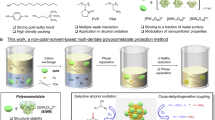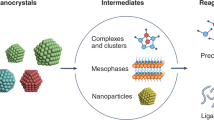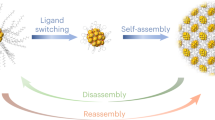Abstract
Surface chemistry is a key enabler for colloidal nanocrystal applications. In this respect, metal oxide nanocrystals (NCs) stand out from other NCs as carboxylic acid ligands adsorb on their surface by dissociation to carboxylates and protons1,2, the latter proving essential in electron transfer reactions3. Here, we show that this binding motif sets the stage for chemically driven ligand displacement where the binding of amines or alcohols to HfO2 NCs is promoted by the conversion of a bound carboxylic acid into a non-coordinating amide or ester. Furthermore, the sustained ligand displacement, following the addition of excess carboxylic acid, provides a catalytic pathway for ester formation, whereas the addition of esters leads to NC-catalysed transesterification. Because sustained, chemically driven ligand displacement leaves the NCs—including their surface composition—unchanged and preserves colloidal stability, metal oxide nanocrystals are thus turned into effective nanocatalysts that bypass the tradeoff between colloidal stability and catalytic activity.
This is a preview of subscription content, access via your institution
Access options
Subscribe to this journal
Receive 12 print issues and online access
$259.00 per year
only $21.58 per issue
Buy this article
- Purchase on Springer Link
- Instant access to full article PDF
Prices may be subject to local taxes which are calculated during checkout





Similar content being viewed by others
References
De Roo, J. et al. Unravelling the surface chemistry of metal oxide nanocrystals, the role of acids and bases. J. Am. Chem. Soc. 136, 9650–9657 (2014).
De Roo, J. et al. Carboxylic-acid-passivated metal oxide nanocrystals: ligand exchange characteristics of a new binding motif. Angew. Chem. Int. Ed. 54, 6488–6491 (2015).
Schrauben, J. N. et al. Titanium and zinc oxide nanoparticles are proton-coupled electron transfer agents. Science 336, 1298–1301 (2012).
Ibáñez, M. et al. Electron doping in bottom–up engineered thermoelectric nanomaterials through HCl-mediated ligand displacement. J. Am. Chem. Soc. 137, 4046–4049 (2015).
Tang, J. et al. Colloidal-quantum-dot photovoltaics using atomic-ligand passivation. Nature Mater. 10, 765–771 (2011).
Lee, J. S., Kovalenko, M. V., Huang, J., Chung, D. S. & Talapin, D. V. Band-like transport, high electron mobility and high photoconductivity in all-inorganic nanocrystal arrays. Nature Nanotech. 6, 348–352 (2011).
Llordes, A., Garcia, G., Gazquez, J. & Milliron, D. J. Tunable near-infrared and visible-light transmittance in nanocrystal-in-glass composites. Nature 500, 323–326 (2013).
Green, M. L. H. & Parkin, G. Application of the covalent bond classification method for the teaching of inorganic chemistry. J. Chem. Educ. 91, 807–816 (2014).
Zherebetskyy, D. et al. Hydroxylation of the surface of PbS nanocrystals passivated with oleic acid. Science 344, 1380–1384 (2014).
Owen, J. S., Park, J., Trudeau, P. E. & Alivisatos, A. P. Reaction chemistry and ligand exchange at cadmium-selenide nanocrystal surfaces. J. Am. Chem. Soc. 130, 12279–12280 (2008).
Fritzinger, B., Capek, R. K., Lambert, K., Martins, J. C. & Hens, Z. Utilizing self-exchange to address the binding of carboxylic acid ligands to CdSe quantum dots. J. Am. Chem. Soc. 132, 10195–10201 (2010).
Dierick, R. et al. Surface chemistry of CuInS2 colloidal nanocrystals, tight binding of L-type ligands. Chem. Mater. 26, 5950–5957 (2014).
Anderson, N. C., Hendricks, M. P., Choi, J. J. & Owen, J. S. Ligand exchange and the stoichiometry of metal chalcogenide nanocrystals: spectroscopic observation of facile metal-carboxylate displacement and binding. J. Am. Chem. Soc. 135, 18536–18548 (2013).
Shylesh, S., Schunemann, V. & Thiel, W. R. Magnetically separable nanocatalysts: bridges between homogeneous and heterogeneous catalysis. Angew. Chem. Int. Ed. 49, 3428–3459 (2010).
Huang, W., Hua, Q. & Cao, T. Influence and removal of capping ligands on catalytic colloidal nanoparticles. Catal. Lett. 144, 1355–1369 (2014).
Wu, Z. et al. Thiolate ligands as a double-edged sword for CO oxidation on CeO2 supported Au25(SCH2CH2Ph)18 nanoclusters. J. Am. Chem. Soc. 136, 6111–6122 (2014).
Zeng, H. C. Integrated nanocatalysts. Acc. Chem. Res. 46, 226–235 (2013).
Niu, Z. & Li, Y. Removal and utilization of capping agents in nanocatalysis. Chem. Mater. 26, 72–83 (2014).
De Roo, J. et al. Fast, microwave-assisted synthesis of monodisperse HfO2 nanoparticles. J. Nanopart. Res. 15, 1778 (2013).
Hens, Z. & Martins, J. C. A solution NMR toolbox for characterizing the surface chemistry of colloidal nanocrystals. Chem. Mater. 25, 1211–1221 (2013).
Rosen, E. L. et al. Exceptionally mild reactive stripping of native ligands from nanocrystal surfaces by using Meerwein’s salt. Angew. Chem. Int. Ed. 51, 684–689 (2012).
Dong, A. G. et al. A generalized ligand-exchange strategy enabling sequential surface functionalization of colloidal nanocrystals. J. Am. Chem. Soc. 133, 998–1006 (2011).
McNeff, C. V. et al. A continuous catalytic system for biodiesel production. Appl. Catal. A 343, 39–48 (2008).
Kiss, A. A., Dimian, A. C. & Rothenberg, G. Solid acid catalysts for biodiesel production—towards sustainable energy. Adv. Synth. Catal. 348, 75–81 (2006).
José da Silva, M. & Lemos Cardoso, A. Heterogeneous tin catalysts applied to the esterification and transesterification reactions. J. Catal. 2013, 1–11 (2013).
Meher, L. C., Sagar, D. V. & Naik, S. N. Technical aspects of biodiesel production by transesterification—a review. Renew. Sust. Energ. Rev. 10, 248–268 (2006).
Narayanan, R. & El-Sayed, M. A. Catalysis with transition metal nanoparticles in colloidal solution: nanoparticle shape dependence and stability. J. Phys. Chem. B 109, 12663–12676 (2005).
Chen, K., Wu, H. T., Hua, Q., Chang, S. J. & Huang, W. X. Enhancing catalytic selectivity of supported metal nanoparticles with capping ligands. Phys. Chem. Chem. Phys. 15, 2273–2277 (2013).
Jenkins, S. V., Chen, S. & Chen, J. Gold–copper alloyed nanorods for metal-catalyzed organic reactions: implication of surface ligands on nanoparticle-based heterogeneous catalysis. Tetrahedron Lett. 56, 3368–3372 (2015).
Cano, I. et al. Air-stable gold nanoparticles ligated by secondary phosphine oxides as catalyst for the chemoselective hydrogenation of substituted aldehydes: a remarkable ligand effect. J. Am. Chem. Soc. 137, 7718–7727 (2015).
Acknowledgements
This work was financially supported by the Research Foundation Flanders (FWO). We are grateful to P. Van Der Voort and E. De Canck for scientific discussions regarding the catalytic properties. The NMR equipment used in this work was financed through a grant from the Hercules Foundation (AUGE09006). Z.H. acknowledges funding from the European Commission via the Marie-Sklodowska Curie action Phonsi (H2020-MSCA-ITN-642656), BelSPo (IAP 7.35, photonics@be), the Research Foundation Flanders (research project G.0760.12) and Ghent University (GOA 01G01513).
Author information
Authors and Affiliations
Contributions
J.D.R. designed and carried out the experiments, interpreted the data, made the figures and wrote the manuscript. I.V.D. and Z.H. initiated the research and supervised the experiments. Z.H. also wrote the manuscript. J.C.M. supervised the research, provided the NMR instrumentation and aided in interpretation and discussions regarding the NMR data. All authors commented on the manuscript.
Corresponding authors
Ethics declarations
Competing interests
The authors declare no competing financial interests.
Supplementary information
Supplementary Information
Supplementary Information (PDF 1164 kb)
Rights and permissions
About this article
Cite this article
De Roo, J., Van Driessche, I., Martins, J. et al. Colloidal metal oxide nanocrystal catalysis by sustained chemically driven ligand displacement. Nature Mater 15, 517–521 (2016). https://doi.org/10.1038/nmat4554
Received:
Accepted:
Published:
Issue Date:
DOI: https://doi.org/10.1038/nmat4554



